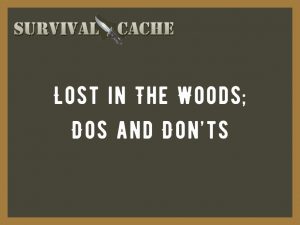For whatever reason, you may one day find yourself in an outdoor survival situation. Maybe you are on an outing with family or friends, one thing leads to another and before you know it, you are lost.

When this happens a million and one things will begin racing through your head. Things like, “Where did I go wrong? I should have gone left instead of right. Do I keep going in this direction or should I go that way or should I sit and wait for someone to find me.?” These are just some of the things that may go through your mind.
From the get-go, it is important to have a survivor’s mindset. This means that there are things that you should do and things that you should not do to ensure the safest outcome. With that in mind, I wanted to share with you my list of lost in the woods do’s and dont’s.
SKIP AHEAD
What To Do When Lost In The Woods
Stop and collect yourself

Inevitably the first thing to happen when becoming lost is to panic. This is completely natural as not knowing where you are or which direction you should go is an unsettling feeling. The best thing to do when this happens is to stop, sit down, and collect yourself. Panicking breeds bad decisions which will only serve to make a situation worse.
Give yourself a break and realize this is not the time to beat yourself up, there will plenty of time for that when you are comfortably back home. Do your best to keep a positive and productive mindset.
Keep Your Hands to Yourself
Remember in grade school when you had to stand in line and keep your hands to yourself? Remember that rule when you are walking through the woods. From poisonous plants, biting insects, thorns, snakes, and everything else hiding in plain sight, your best bet is to keep your hands to yourself.
Retrace your steps

There are some situations where retracing your steps is not recommended. If the wrong direction is chosen it will lead a person further astray. However, if you are not too far off of the main path, you have navigational tools or you can positively figure out the direction to safety, retracing your steps may be the safest option.
Make noise while you move
Making noise while walking through the woods is a precaution to take in predator country (mainly bear country) One thing you don’t want to do is to surprise an animal that can harm you.
But this tactic does not apply to predators alone. While you may feel lost, there could be people just over the hill or around the next bend. By singing or making noises they may be drawn to your location.
Assess the situation
When you have reached a point that you know you are lost and it is likely you will be spending the night under the stars, it is time to fully assess the situation. Figure out all of the supplies that you have, this means turning every pocket inside out. Follow the Rules of 3 to prioritize what you need to do and to keep your mind busy with productive tasks.
Stay next to a vehicle
This piece of advice is not absolute and is strictly dependent on the circumstances. But generally speaking, when a person has become lost and there is a vehicle present (car, boat, plane, etc.) the best practice is to stay next to that vehicle. There are two reasons for this. The first is that the vehicle provides resources such as a shelter. The second reason is that a vehicle will be much easier to spot than a person by a rescue team.
The reason I believe this piece of advice is not an absolute is that it can change from one situation to another. If a person knows the direction to safety, they have supplies, skills, and abilities, then the decision can be made whether or not to self-rescue.
Make sure to always pack a car survival kit so you have the necessary items to survive.
Blaze a trail
This tactic should be done from the beginning of the journey to help avoid becoming lost in the first place or from becoming further lost. This technique utilizes whatever is at hand for marking the path that is being taken. A knife can be used to mark trees, branches can be bent or broken, arrows can be drawn or pieces of signaling tape can be hung. It is helpful to make these signs as visible as possible and to make them in a way that indicates direction.
What Not To Do When Lost In The Woods
Don’t Step Over a Log

It is not a good idea to step over a log without knowing what is on the other side. Logs can conceal animals laying down, such as a snake or they can hide holes that can easily turn an ankle. It is a safe practice when coming upon a log (or any other object) to take a moment to look before stepping.
Stay Away From the Edges!
When you come to an overlook point on a hill or rocky outcrop, stay away from the edges. If a person becomes dizzy or disoriented, they can lose their balance. Additionally, there may not be much support underneath these areas. They can easily give away under a person’s weight. The same applies when walking along riverbanks which have been undercut by the water’s current.
Don’t Discard Anything
Even if something appears to be completely not useful, I suggest holding onto it as long as possible. In a survival situation, what is on your person is all that you have and you never know when or how something could be used.
Don’t Consume What the Animals Consume
Consuming what animals consume is one of those outdoor myths that is false. Animals are accustomed to drinking and eating from the environment they live in. Just because they can do it does not mean it is safe for people. Always go through the steps to make water potable and make sure that you can positively identify food sources that are safe for human consumption.
Stay Out of the Water

If you are in a cold environment or one with large temperature fluctuations, it is never a good idea to get wet. This may seem obvious but it is also easy to forget, especially on a small scale. Walking or wading across a shallow stream for example might seem like an okay thing to do. While only a portion of clothing may be wet, it can still have a huge negative impact once temperatures begin to fall.
Don’t Run
Running when you first become lost only serves to indulge a panicked emotion. Running any time after that should never be done unless there is an immediate threat to safety and life. Running drastically increases the chances of an injury that you may or may not be able to recover from. Almost everything in a survival situation needs to be done slowly and deliberately to produce the safest result.
Wrap Up
There are lots of things to be aware of in any environment if you find yourself in a survival situation. The above are some of the big items that come to my mind when in the woods. Wherever you find yourself, slow down, be thoughtful in your process, and deliberate in your actions. Stay safe!


